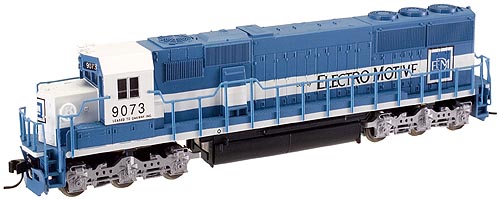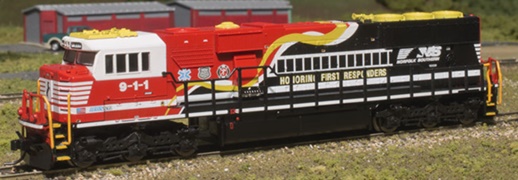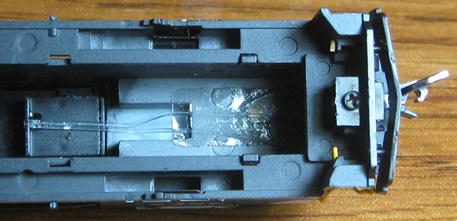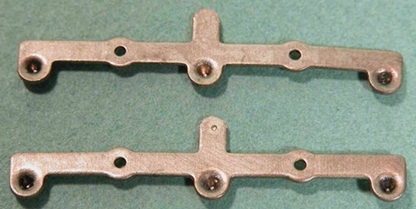| SD60 | SD60M |
 |
|
| SD60E | SD50 |
 |
|
| SD60 | SD60M |
 |
|
| SD60E | SD50 |
 |
|
Introduced: 1998 (SD60), 1999 (SD60M and SD50), 2002 (revised SD60M and SD50), 2005 (revised SD60), 2019 (SD60E/SD50/SD60 w/ DCC-Sound) and 2024 (E24 SD50)
There have been two distinctly different versions of the chassis used in these models. The original (1998) version is fairly typical of Atlas diesels from that era -

Note the extended headlight shield on the SD60M -
The DCC-Ready chassis is all-metal and split-frame. The motor is five-pole and skew-wound. Each motorshaft has a large brass flywheel. All wheels provide pickup via low-friction axle-cup wipers. There are no traction tires. All axles are geared and all gearing is plastic. The main PC board (or decoder) provides directional LED lighting. The wheels are blackened and low-profile. Couplers are shell-mounted. All come with separate snowplow and winterization hatch details (to be installed by the modeler).
These models initially came with Rapido-style couplers. Starting with the 2002 run, new features included Accumate couplers, Atlas's "slow speed" motor, two-tone handrail painting, and golden/white LEDs on the PC board (or decoder).
Performance on these pre-2019 models is perfect in every way - smooth, quiet, flawless pickup and throttle response, exceptional pulling power, etc.
In 2019, the internals were completely redesigned to include support for an ESU LokSound DCC-Sound decoder and accompanying speaker. Analog versions and non-sound DCC versions were also part of this release, along with an all new shell (SD60E). Instead of using screws and hex nuts to hold the chassis halves together, this new version uses plastic clips on either end of the chassis (the fuel tank and motor saddle also contribute to holding things together) -

Gone are the chassis contact strips that the truck axle-wipers used to rub up against (an Atlas staple since the 1980's). Instead, small wires are soldered to the axle-wipers on the one end and to cylindrical metal plugs (which insert into holes in the chassis) on the other. Note that the plugs are rather tight-fitting, so it's best to push them out from the inside (as opposed to trying to pull them out from the outside).

The rest of the internals are more or less the same as before. A five-pole / skew-wound motor spins dual flywheels. In turn, the flywheels spin plastic shafts with notched-cups on the worm side. Said cups spin little ball-and-pin connectors on the wormshafts. Bearing blocks inside of notches in the chassis hold the brass worms in place. A long plastic shield is clipped to the top of the chassis (dunno why - but maybe to prevent short circuits between the decoder and chassis?)

I particularly like the way the circuit boards (and contacts thereto) have been redesigned. Very similar to IMRC's SD40-2 of 2017, metal contacts on the motor saddle transfer current from the main PC board (or decoder) to the motor and to the speaker mounted inside the fuel tank (note that even the non-sound locos come with a speaker). Unlike previous Atlas locos, the main PC board slides in and out of its chassis slots without requiring that one first partially disassemble the chassis (a nicety that Kato has offered for years). The design and placement of the new PC board contacts is also an improvement over previous Atlas diesels (where getting the motor contacts to line up with the contact pads on the PC board was admittedly a bit "hit and miss").
All twelve wheels provide pickup, all six axles are geared, and all gearing is plastic. The wheels are blackened and low-profile. The trucks and fuel tank appear to be the same as on previous versions (in fact, the fuel tank still bears its "1998" copyright stamp). Note that speaker holes in the fuel tank aren't really required since the speaker is positioned such that sound projects upward rather than downward.

AFAIK, there were no changes to the SD50/SD60 shells with this release (IE, older shells will work with this newer chassis, and vice versa). However, SD60M's were not part of the 2019 release and old SD60M shells will not work with the new chassis (not without major modification anyway). The front of the SD60M sidesill has an extended lip at the front that needs to be pruned back. Also, the light conducting plastic used in SD60M's equipped with a nose headlight pretty much has to be removed entirely.

The new shells are all plastic and include separate detail parts for the windows, numberboards, handrails, cab, sidesills, and horn (the SD60E's also come with ala carte sunshades to be installed by the modeler). Couplers are shell-mounted Accumates. The SD60E models include operating ditchlights on both the front and the back. Said ditchlights are programmed to flash on the DCC-equipped versions (cycling between dim and bright), however since a single LED on each end provides the light, they do not strobe. As pictured above, the LEDs on the new chassis are much farther away from the light-conducting plastic in the SD50 and SD60 shells than they used to be, and the end result is that the headlight, backup light and numberboard lighting is barely visible.

The new SD60E was designed with a lot of fancy light tubing inside the shell, and consequently all of the lighting is nice and bright. Not retrofitting the older shells similarly seems like a bit of laziness on Atlas's part to me.


Performance on this new version is every bit the equal of its predecessors. Out of the box, I didn't have any problems with the wheel-blackening causing any sort of jitteriness. They run very quietly, throttle response is smooth, pickup is flawless, slow speed creep is "one-time-at-a-time" and the top-end speed is realistic (IE, not too fast). Pulling power is strong, with mine comfortably able to haul 30+ assorted freight cars through curves on level track. No problems with any of the wheels derailing (even on 9.75" radius curves). Overall, just really superb looking and running models.
The sound on the DCC-Sound versions is well rendered and nicely beefy. And for a change, the default settings for volume are quite reasonable. I didn't notice any difference in performance when operating mine with an analog powerpack (IE, they run equally well using DCC or DC control). As seems to be typical with DCC-Sound models these days, the decoders in these locos are programmed to go through a rather protracted sequence of "start up" shenanigans before they start moving (and with similar behavior when slowing down). To eliminate this nonsense (if you're so inclined), simply set CV124 to 0. Also note that the default behavior is for the sound to be off (IE, put the loco on the rails and it won't make a peep). To turn sound on, hit F8. Unfortunately, none of this information is included with the model (handy paper inserts apparently being a thing of the past), so you'll need to hunt down the appropriate .pdf manual on the Atlas website when you have questions. IE, welcome to the 21st century.
Also, I should note that I did have a number of performance issues with the first 2019 SD60 that I purchased (noisy, bad pickup, excessive lube, and desoldered truck wires). So, I sent it back for replacement (and picked up an SD60E at the same time). And although both of those turned out to be flawless, it does appear that QC may be a bit spotty with this run of models. So, just be sure to hang on to your receipts.
As noted above, these models were revised yet again in 2024, and with all of the changes being lighting related. For starters, a new lightboard with an E24 DCC interface replaced the old light board / decoder board setup of the 2019 models. And tangentially, the shroud for the forward LED was changed as well -

Additionally, the light conducting plastic inside the shell was changed to accommodate the new light board (as well as provide support for ditch lights) -

So, the good news there is that Atlas addressed all the lighting deficiencies of the 2019 models, and the bad news is that swapping shells with earlier versions just got a whole lot harder. As for the ditch lights, my SP SD50 did not have flashing ditch lights ala my SD60E, but maybe that's just CV settings (IE, if you want flashing ditch lights, it probably time for you to RTFM).
One oddity with all of these models is that the dimpled axle wipers in the trucks are not identical (IE, there is a "left side" wiper and a "right side" wiper). This is due to the fact that the forward and rear axles are not the same distance from the center axle (a difference of about .030"). It's not really noticeable unless you're looking for it, but if you've taken your trucks apart and find that, once reassembled, they no longer roll freely, you've gotten the wipers installed backwards.

Prototype information -
EMD introduced the SD50 in the early 1980s with a 16 cylinder, 3500 h.p. engine to attain the power that they had early gotten from a 20 cylinder locomotive. The new, longer frame allowed the dynamic brake resistors to be relocated to a cooler area found between the central air intake and the cab. The SD60 varied little from its predecessor visually, the main changes taking place internally with the aging 645F engine being replaced by the 710G. The two locomotives can be distinguished by the door panels; the SD50 features four latched doors in six door panels whereas the SD60 has six latched doors in eight door panels.
The "wide nose" or "safety cab" SD60M was first offered as an option to US railroads in 1988. Union Pacific received the first units in early 1989. In 1991, the contour of the nose was changed slightly, going from a 3-piece to 2-piece windshield and tapering the sides of the nose to improve visibility for the crew. Burlington Northern was the first recipient of the revised model. The SD60E is a custom SD60 rebuilt by the Norfolk Southern at their Juniata Shops starting in 2010. The SD60E utilizes a new NS-designed "Crescent" cab with a wide short hood, replacing the "spartan" cab. The upgrade also includes new electronics and engine upgrades.
Features (2019 version) -
- Directional lighting with golden white LEDs
- Blackened metal wheels
- Scale Speed motor
- AccuMate magnetic knuckle couplers
- Silver Series locomotives are DCC-Ready and come equipped with a speaker for quick conversion to DCC-Sound
DCC Features (Gold Series locomotives) -
- Supports all DCC programming modes
- DCC includes RailCom and RailComPlus, with 14, 28 or 128 speed steps and with 2-digit and 4-digit addressing
- Flexible mapping of function keys F0 to F28
- A total of 6 DCC function outputs are available, and all can be function mapped (disable, brightness, light effects) individually
- Follows all NMRA DCC standards and recommended practices
- Over 20 sound effects are available, including engine start-up and shutdown, prime mover sounds through all eight notches, bell, air horn, air compressor,
dynamic brakes and more
- There are up to 16 user-selectable horns, 2 user-selectable bells, and 2 user-selectable synchronized brake squeals
- Equipped with ESU's Exclusive "Full Throttle" features for ultimate realism in prototype running
Shell Removal -
Shell removal on these models is pretty simple, just take hold of the fuel tank with one hand and the shell with the other, then just sort of wiggle it up and off.
Grade: A (except for the 2019 SD50 and SD60 models, which I can only give a B due to the lighting situation)
SD60 reviewed: 1/99 Model Railroader: ("This new EMD standard-cab SD60 from Atlas is a nice model, and the good news for those using DCC is that, following in the footsteps of the firm's earlier GP40-2, Atlas is offering the model in both conventional and Lenz DCC decoder-equipped versions... The model matches the prototype nicely, scaling out at 67' long and 14'-8.75" tall. The Atlas model follows conventional N scale diesel locomotive construction, with an injection-molded styrene shell that fits over a split frame that surrounds a five-pole, skew-wound motor. The model has directional lighting, blackended metal wheels, and dual brass flywheels. The shell is a one-piece casting including the walkways, but with a seperate cab. The molding is sharp, with most details, including grab irons, lift rings, grills, and fans, molded in place. The brake wheel, horns, and plow are seperate pieces. A winterization hatch is included, to be added by the modeler... Acetal plastic handrails and stanchions are molded in color to match the body, but the green on our BN sample doesn't quite match the paint on the locomotive, and the handrails have a rather waxy appearance... The model runs smoothly, although it was a bit noisy until it had been run for a few hours. It responds well to the throttle, and I don't really mind that its top-end speed is extremely high since it runs very well at low speeds... The locomotive comes with Rapido couplers... All axles are powered, and all wheelsets were in gauge... Printing and lettering on the model live up to the standards we've come to expect from Atlas... This large, modern locomotive will be a welcome addition to the rosters of many N scale railroads hungry for high-horsepower engines. BN, C&NW, Conrail, CSX, EMD, NS, Oakway, Soo, UP. Price: $92.95 (or $132.95 with decoder)")
SD50 reviewed: 9/99 Model Railroader ("This Atlas SD50 is an excellent replica of the heavy-duty road diesel introduced as part of EMD's Fifty Series locomotive line in 1981. The model looks good and has a powerful, smooth-running mechanism... The model follows the proven design of previous Atlas N scale models starting with superbly detailed plastic body shell. It's made up of several interlocking pieces secured with concealed latching tabs. The pilot, walkway, and sill casting fits closely over the mechanism and then the body snaps into it, Window glazing, number boards, and headlight lenses snap into the cab, which then slides into place from the top. The air horns, brake wheel, fuel tank, handrails with stanchions, and plow are separate details that are press-fit onto the body. The handrails are acetal plastic. The same mechanism that drives the recent Atlas SD60 and SD60M locomotives also powers this model... It has a heavy split frame which encloses the five-pole skewed-armature motor and a pair of turned brass flywheels. All of the axles are driven and all of the wheels pick up electricity by way of phosphor-bronze contact strips. A PC board is mounted on top of the motor. On standard DC models, this board contains diodes for the directional headlights. Atlas also offers SD50s equipped with Lenz DCC decoders. On these models the decoder replaces the original PC board. The model has full pilots and comes with Rapido couplers, but MT 1015-1016 knuckle couplers may be easily substituted. Our sample SD50 started and ran smoothly throughout its speed range. The slow-speed performance is excellent, but you'll be doing your running in the lower third of the power pack control as the top end is way beyond any normal operating speeds. The model's drawbar pull is equivalent to about 26 free-rolling cars on straight and level track. Our sample was neatly painted in Seaboard System colors. Its lettering is clear and sharp and even has the numbers in the number boards - a nice touch. This is another well-detailed EMD locomotive from Atlas, and modelers of the modern era will enjoy it. Chessie, D&RGW, MP, Seaboard. $92.95 ($132.95 with decoder)")